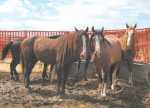Fire ruins range, forces wild horse roundup

The Bureau of Land Management gathered over 300 wild horses from the Saylor Creek Herd Management Area last week, and another 156 on Monday.
The emergency round up was required following the Clover fire that scorched 193,000 acres of rangeland on which they graze in July. The fire, which began near Bruneau on July 15, was finally contained just west of Castleford five days later.
The 83,540 acre Saylor Creek Herd Management Area (SCHMA) contains the highest concentration of wild horses in Idaho. Nearly half of the more than 700 wild horses in Idaho live in the area. The fire destroyed approximately 13,000 acres in the management area.
Two reasons exist for removing the horses from the SCHMA, BLM officials said. The horses' customary foraging grounds were destroyed by the fire, but the horses began returning to the area to graze on a few islands of grass that still remained.
The islands do not provide enough food to sustain the herd for a long period of time, said Mike Courtney, BLM Twin Falls District Rangeland Manager, and the agency needed to remove the animals before they began to show signs of malnutrition.
Secondly, a successful rehabilitation of the burnt area relies on the removal of the animals for at least two growing seasons.
"A gather for this herd was originally planned for November, with an adoption to follow in December," Courtney said. But the emergency gather that took place last week will move up the adoption deadline to September, he noted.
The Twin Falls and Boise districts worked together on last week's operation.
Typically, wild horse gathers are done using BLM employees but due to the need for immediate removal of the animals K&G Livestock from Vernal, Utah, was hired for last week's operation.
Using a helicopter, the bands of horses, numbering anywhere from 10 to more than 40, were gathered and herded towards temporary corrals, where they were marked with paint, separated by gender an/or age, then loaded into livestock carriers for transport to holding pens in Boise and Utah. Once they reach their destination the animals will be vaccinated, wormed and tested for Coggins disease, an incurable viral disease transmitted by horseflies.
"Immediately following the fire we began hauling water to the horses," Courtney indicated. "We repaired an existing pipeline and are now able to pipe water to the horses."
There are no natural water sources on the SCHMA. All livestock water, including that used by cattlemen who hold grazing permits in the area, is provided from wells developed by the BLM, Courtney said.
Livestock currently grazing on allotments affected by the fire area also are being removed. Twenty-one allotments were burned in whole or part, so the use of forage by livestock needs to be temporarily be reduced.
"A rest period will be in affect for the next two growing seasons to accommodate rehabilitation efforts on the burned area," Courtney said.
Of the 350 horses expected to be removed from the SCHMA, 112 will be reintroduced after the "rest" period. In the meantime, the BLM will fence off a large enough area in the SCHMA to accommodate the returning animals. The other horses will be put up for adoption both in Idaho and Utah.
Some of the stallions were sent to Utah. Courtney explained that about 60 percent of the horses gathered last week were males, and the Boise holding pens cannot safely accommodate that many stallions.
The BLM has been managing Idaho's wild horse population since 1971 after Congress passed the Wild Free-Roaming Horse and Burro Act in an effort to manage and preserve the country's wild horse and burro populations.
Part of that management is the occasional thinning of herds to relieve stress on management areas, and to reintroduce new stallions to reduce inbreeding.
The horses gathered last week ranged in color from roan to palomino, and appeared in good condition.
The wild horses of the Saylor Creek Herd Management Area were not the only animals affected by the devastating Clover fire. Several cattle operations also lost vital grazing land. It could be at least two years before they are permitted to re-enter the area.
Ann Wilson, whose family owns Hammett Livestock Company, estimates that the Clover fire destroyed 60 percent of the ground the company uses for spring, summer and fall grazing. The company has grazed its sheep and cattle in the area for at least 40 years.
The BLM has not determined how to handle reintroduction into those areas used by Hammett Livestock, Wilson said. "We are hoping with some fall moisture that we will be able to stay out until December."
Nearly 7,400 acres of land affected by the Clover fire is managed by the Idaho Department of Lands. The IDL manages historical endowments, which generate revenue for schools and other state agencies.
Tim Duffner, Area Manager for the Idaho Department of Lands Twin Falls office, said the agency is still assessing the damage and will, based on that assessment, determine how to proceed with rehabilitating the areas that were burned.
A possible deferment of some grazing permits may be necessary, he indicated, which could affect Hammett Livestock and several other stock owners.
Mountain Home Air Force Base also uses some of the agency's land for a bombing range. How those operations will be affected, if at all, also will be reviewed.
